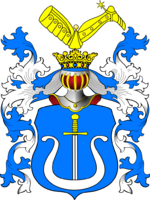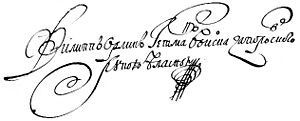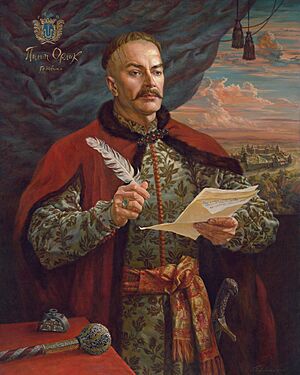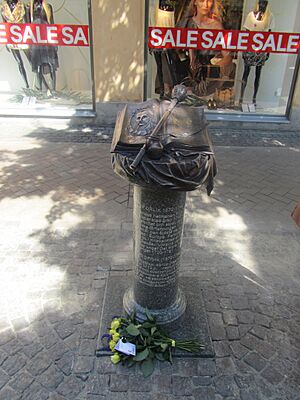Pylyp Orlyk facts for kids
Quick facts for kids
Pylyp Orlyk
|
|
|---|---|
| Пилип Орлик | |
| Hetman of the Zaporozhian Host (in exile) |
|
| In office April 5, 1708 – May 24, 1742 |
|
| Preceded by | Ivan Mazepa |
| Personal details | |
| Born | October 11 (21), 1672 Kosuta, Polish–Lithuanian Commonwealth (now Kasuta, Belarus) |
| Died | May 26, 1742 Jassy, Principality of Moldavia (now Iași, Romania) |
| Spouse | Hanna Hertsyk |
| Signature |  |
Pylyp Stepanovych Orlyk (Ukrainian: Пилип Степанович Орлик; Polish: Filip Orlik; October 21 [O.S. October 11] 1672 – May 26, 1742) was an important Ukrainian leader. He was a statesman, a diplomat, and a starshyna (a high-ranking officer) for the Zaporozhian Cossacks. He became a Hetman, which was like a military and political leader, but he led "in exile" from 1710 to 1742. This means he led from outside Ukraine. He worked closely with Ivan Mazepa and wrote a very important document called the Constitution of Pylyp Orlyk.
Contents
Who Was Pylyp Orlyk?
Pylyp Orlyk was born in a village called Kosuta, which is now in modern-day Belarus. His birthday was on October 21, 1672. His family was noble, meaning they came from an old, respected family. His father, Stefan Orlik, sadly died in a battle against the Turks when Pylyp was just a baby. Pylyp's mother, Irena, made sure he was baptized in the Orthodox Christian faith.
Pylyp was very smart and went to good schools. He first studied at a Jesuit college in Vilnius. Then, he went to the famous Kyiv Mohyla Academy until 1694. After finishing his studies, he started working in government. In 1698, he became a secretary for the church in Kyiv.
Working with Hetman Mazepa
In 1699, Pylyp Orlyk joined the General Military Chancellery, which was like the main government office for the Hetman. By 1706, he became the general chancellor. This made him the closest helper to Hetman Ivan Mazepa. Pylyp Orlyk helped Mazepa with secret letters and plans. He worked to create a group of countries that would stand against Russia.
Becoming a Hetman in Exile
After a big battle called the Battle of Poltava in 1709, Pylyp Orlyk had to leave Ukraine. He escaped with Hetman Ivan Mazepa and King Charles XII of Sweden to a place called Bender in Moldavia. Mazepa died there soon after. The Cossacks and the Swedish king then chose Pylyp Orlyk to be their new Hetman.
While in Bender, Pylyp Orlyk wrote one of the first state constitutions in Europe. This document is known as the Constitution of Pylyp Orlyk. King Charles XII of Sweden approved it. The constitution also called him "the protector of Ukraine."
Life in Exile and Travels
Between 1711 and 1714, Pylyp Orlyk tried to lead some attacks into Ukraine with the help of Crimean Tatars and small groups of Cossacks. These attempts were not successful. After this, Pylyp Orlyk and some other Cossacks traveled with the Swedish king Charles XII. They went through places like Vienna and Stralsund.
Orlyk, his family, and about 40 other Cossacks arrived in Sweden in late 1715. They lived in the city of Kristianstad for a few years. Orlyk and his family left Stockholm in 1720. Even years later, in 1747, his wife and children still received money from the Swedish Parliament.
From Sweden, Orlyk traveled a lot. He went to Hamburg, Hannover, Prague, Wrocław, and Kraków. In Kraków, he left his family to stay in a monastery. Orlyk stayed in Poland until 1722. Then, he moved to Khotyn in Moldavia, which was part of the Ottoman Empire. From there, he went to Thessaloniki. In 1734, he moved to Căușeni in Moldavia. He later stayed in Iași and then Bucharest. He passed away in Iași, Romania, in 1742.
His Important Writings
Pylyp Orlyk wrote many important papers and essays about Ukraine. The most famous is the 1710 Constitution of Pylyp Orlyk. He also wrote a very long diary, over 3000 pages, covering the years 1720-1732. This diary was mostly written in Polish, with some Latin, Church Slavonic, Turkic, Tatar, and Ukrainian words. It also had parts written in French and Latin.
Remembering Pylyp Orlyk
People remember Pylyp Orlyk in many ways. In 2011, a monument was put up in Kristianstad, Sweden. It's on a building where he lived from 1716 to 1719. This monument celebrates 300 years since his constitution was written.
Many streets and alleys in Ukraine are named after Pylyp Orlyk. There are also streets named after him in Vileika (Belarus) and Kristianstad (Sweden).
The National Bank of Ukraine has made special silver coins to honor Pylyp Orlyk (in 2002) and his constitution (in 2010). The Ukrainian postal service, Ukrposta, has also issued stamps in his honor (1997) and for his Constitution (2010).
In 2007, Ukrainian politicians and Ukrainians living in the U.S. started the Pylyp Orlyk International Prize. This award is given every year in Kyiv to important Ukrainian and foreign lawyers.
Several places are named after Hetman Pylyp Orlyk, including a university, a think tank in Kyiv, and a hut in Lviv.
Monuments and memorial signs for Hetman Pylyp Orlyk have been set up in many places. These include Kosuta (Belarus) (2006), Baturyn (Ukraine) (2009), Bendery (Moldova) (2010), Kyiv (Ukraine) (2011), Orlyk in the Poltava region (Ukraine) (2011), Kristianstad (Sweden) (2011), and Ivano-Frankivsk (Ukraine) (2012).
In Baturyn, there is a large monument called "Hetmans. Prayer for Ukraine." It shows five Ukrainian hetmans, including Pylyp Orlyk. He stands next to his mentor, Ivan Mazepa, showing how their ideas were connected. This monument was opened in 2009.
His Family
|
Pylyp Orlyk
|
|
|---|---|
| Coat of arms |  |
| Noble family | Orlyk |
Pylyp Orlyk married Hanna Hertsyk on November 13, 1698. Hanna was the daughter of Colonel Pavlo Semenovych Hertsyk, who was a close friend of Hetman Mazepa. Pylyp and Hanna had eight children together.
- Anastasiya Orlyk (1699–1728) was born in Poltava. She married a Swedish nobleman in 1723 and had two sons.
- Grégoire Orlyk (1702–1759) was born in Baturyn. Hetman Ivan Mazepa was his godfather. He studied at Lund University in Sweden. He later became a Lieutenant General in France and called himself Comte d'Orlik. He visited Sweden in 1742. He married a French noblewoman but had no children. He died in battle in Germany in 1759.
- Mykhailo Orlyk (born 1704) was also born in Baturyn, and Hetman Ivan Mazepa was his godfather.
- Varvara Orlyk was born in Baturyn, and Hetman Ivan Mazepa was her godfather too.
- Yakiv Orlyk (born 1711) was born in Bender, and King Charles XII of Sweden was his godfather.
- Marta Orlyk (born 1713) was born in Bender, and King Stanisław Leszczyński of Poland was her godfather.
- Maryna Orlyk (born 1715) was born in Altefähr, Sweden. Her godparents were King Charles XII's sister and King Stanisław Leszczyński.
- Kateryna Orlyk (born 1718) was born in Kristianstad, Sweden, and likely died young.
See Also
- Constitution of Pylyp Orlyk
- List of Ukrainian rulers




